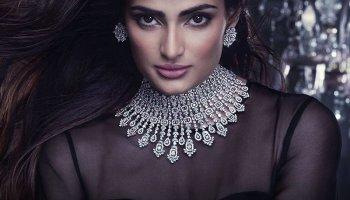The Fascinating Evolution of Indian Jewellery

The history of
India and the evolution of its jewellery are almost inseparable. Leaning as far
back as five thousand years ago, the advent of jewellery may have been to
embellish and adorn, but over the years it has come to mean much more than
that. Playing various roles such as the mark of a person’s status, the
harbinger of financial security, and a significant part of various rituals,
jewellery has become so intertwined with culture that it is difficult to speak
of one without mentioning the other.
Simple yet
elegant pieces of jewellery are amongst the most commonly found relics of the
Harappan civilization. Various ornaments made of different materials such as
gold, copper, silver, pottery, ivory and more have been found and go on to show
how deep the roots of jewellery-making penetrate back into time.
Another
important landmark for jewellery was the time of temple jewellery. While the
originals were meant only for deities, imitations of the classical pieces of
jewellery later began to be worn by Bharatnatyam and Kuchipudi dancers. These
pristine pieces are works of exquisite skill and talent and display a certain
finesse that comes only with the hard work of the craftsmen. Precious stones set
in gold provide an unparalleled sense of beauty and timelessness.
Jumping to many
years later, when the Mughal rulers raised their flags in India, we see
emerging trends such as the confluence of Indian and Central Asian styles.
Techniques such as the Kundan method of setting various stones in pure gold
were perfected in this period. The technique of inlaying stones in gold was
another significant achievement in this time. Traditional Indian designs were
modified to inculcate designs inspired by nature, geometry and flora.
Similarly, the
Jadau technique may have been brought to the subcontinent by the Mughals but Jadau
jewellery was perfected under Rajasthani and Gujarati artisans, under whom
it flourished, due to the addition of their unique touches.
Later, the 19th
and 20th century brought with it the wave of colonialism and the
need to incorporate their ways into various spheres of life. European
influences seeped into Indian designs, and European jewelers also began to
create pieces for Indian rulers, which brought forth various refined and
innovative designs.
Traditional
Indian jewellery may have been chunky and heavy, but the modern woman desires
the same grace and opulence in a sleek form that does not interfere with work
or feel uncomfortable. Contemporary jewellery thus ranges from minimalistic to
heavily embellished pieces for those who prefer the old ways.
In this land
with a rich and intriguing culture of loving jewellery, whether you seek
ancient jewellery reminiscent of the earlier days or look for the latest wedding
jewellery designs in Delhi, each and every piece will have a story to tell,
a history to fall back upon.
Post Your Ad Here
Comments